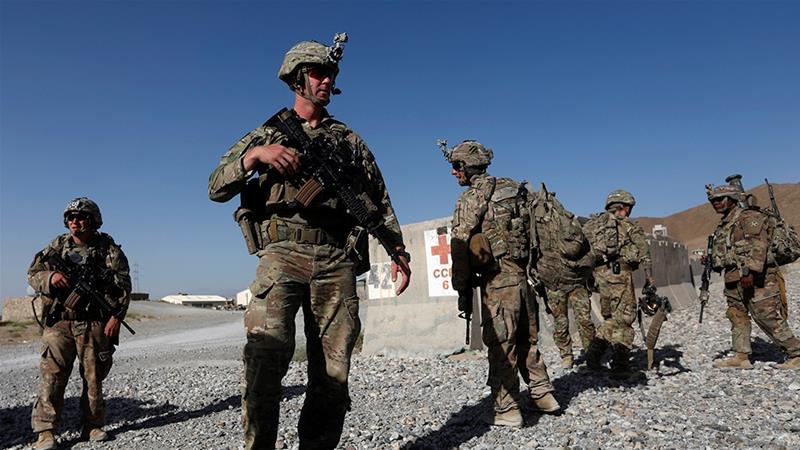Trump says he wants full Afghanistan pullout but sets no timeline
US forces have already begun withdrawing after 19 years of war as part of an agreement signed with Taliban in February.
President Donald Trump on Tuesday renewed his desire for a full military withdrawal from Afghanistan but added that he had not set a target date, amid speculation he might make ending the United States’s longest war part of his re-election campaign.
“We’re there 19 years and, yeah, I think that’s enough … We can always go back if we want to,” Trump told a White House news conference.
More:
-
From the US to Afghanistan: Rediscovering the mother who left me
-
‘People treat you like a celebrity, but also as an infidel’
-
Afghanistan needs a Government of National Reconciliation
Asked if the Thanksgiving holiday on November 26 was a target, Trump said: “No. I have no target. But as soon as (is) reasonable. Over a period of time but as soon as reasonable.”
The US has already begun to withdraw its forces as part of an agreement signed with the Taliban armed group in the Qatari capital Doha on February 29. By the second quarter of 2021, all foreign forces are supposed to withdraw, ending the US’s longest war.
The Taliban launched an armed rebellion after it was toppled from power by a US-led invasion in 2001.
Trump’s comments come as authorities in Afghanistan said they had released about 900 Taliban prisoners across the country on Tuesday, approximately 600 of them from the notorious Bagram jail near Kabul.
The release is a part of a pledge by the Afghan government to free up to 2,000 of the armed group’s prisoners in response to the Taliban’s three-day ceasefire offer, which began on Sunday to mark the Muslim holiday of Eid al-Fitr.
Prisoner release
On Tuesday, the Afghan government urged the Taliban to extend the ceasefire – only the second in nearly 19 years of war – which has mostly held across Afghanistan, providing a rare respite from the conflict’s grinding violence.
“For better management of the prisoner issue, it is important to extend the ceasefire,” Javid Faisal, a spokesman for Afghanistan’s national security adviser, told a news conference.
The release was part of a prisoner swap under the Taliban-US agreement, as a precursor to peace talks between the armed group and an inclusive Afghan delegation aiming to end a two-decades-old war.
Taliban spokesman Suhail Shaheen, in a statement on Twitter, welcomed the release of 900 prisoners as “good progress” and said the group would in turn free a “remarkable number” of prisoners soon.
However, he said nothing about extending the ceasefire, which expired at midnight (19:30 GMT) on Tuesday.
Last month, the Taliban rejected a call by the Afghan government for a Ramadan ceasefire.
‘Bring peace’
Fighting between Taliban and Afghan forces had intensified before the ceasefire, and the government said it would resume an offensive against the armed group in the wake of its deadly attacks nationwide earlier this month.
“As per the guidelines of our leaders, and based on the agreement (the US-Taliban peace deal), we will not return to the battlefield,” a Taliban member, Noor Rahman, told Reuters after being released from Pul-e-Charkhi prison, located on the outskirts of Kabul.
Another freed prisoner, Qari Ahmad Sayeed, said he was delighted to be free, adding, “I hope this will result in bringing peace to the country.”
Faisal said all released Taliban members were being given new clothes, cash and transport home. The process was expected to be completed by midnight – the same time the ceasefire ends.
US Secretary of State Mike Pompeo, while welcoming the latest developments, has insisted that freed Taliban prisoners should not return to the battlefield.
President Ashraf Ghani has said his administration is ready to begin peace negotiations, seen as key to ending the war.
Government negotiators would be headed by Ghani’s former rival Abdullah Abdullah after the two signed a power-sharing deal last week that ended a months-long political crisis.
Prisoner releases began in April, but have been slow and marred by wrangling between the Taliban and the government, which was to free 5,000 prisoners under the Doha pact, while the Taliban would free 1,000 members of the Afghan security forces.
Before this week’s releases, Kabul had already freed about 1,000 Taliban inmates, while the group released about 300 Afghan security force captives.
Source: Read Full Article




